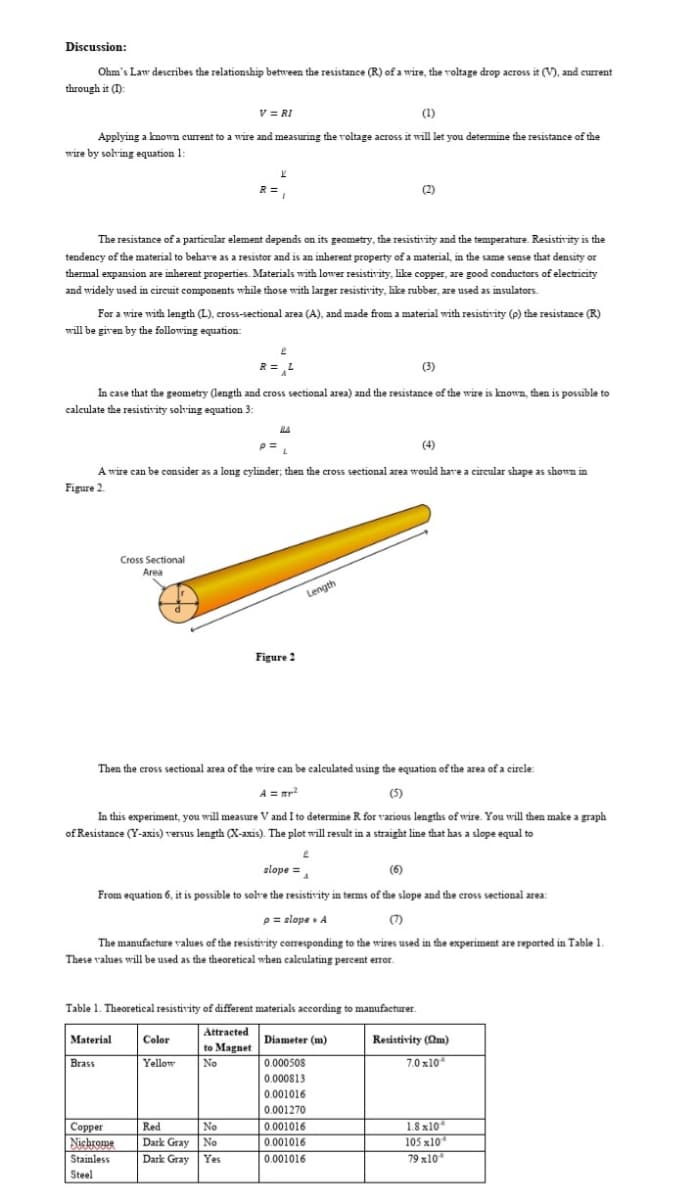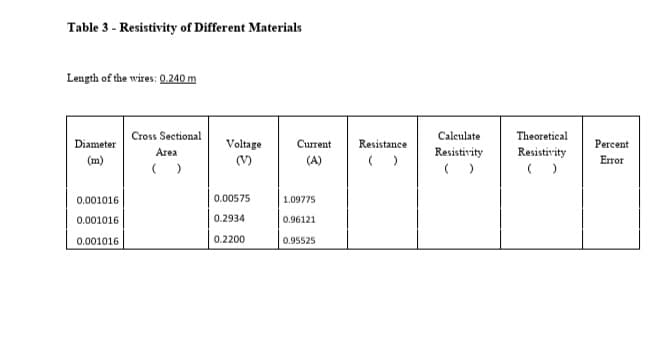Table 3 - Resistivity of Different Materials Length of the wires: 0. 240 m Cross Sectional Caleulate Theoretical Diameter Voltage Current Resistance Percent Area Resistivity Resistivity (m) (V) (A) Error ( ) 0.001016 0.00575 1.09775 0.001016 0.2934 0.96121 0.001016 0.2200 0.95525
Table 3 - Resistivity of Different Materials Length of the wires: 0. 240 m Cross Sectional Caleulate Theoretical Diameter Voltage Current Resistance Percent Area Resistivity Resistivity (m) (V) (A) Error ( ) 0.001016 0.00575 1.09775 0.001016 0.2934 0.96121 0.001016 0.2200 0.95525
Physics for Scientists and Engineers, Technology Update (No access codes included)
9th Edition
ISBN:9781305116399
Author:Raymond A. Serway, John W. Jewett
Publisher:Raymond A. Serway, John W. Jewett
Chapter27: Current And Resistance
Section: Chapter Questions
Problem 27.76AP
Related questions
Question
100%

Transcribed Image Text:Discussion:
Ohm's Law describes the relationship between the resistance (R) of a wire, the voltage drop across it (V), and current
through it (1):
V = RI
(1)
Applying a known current to a wire and measuring the voltage across it will let you determine the resistance of the
wire by solving equation 1:
(2)
The resistance of a particular element depends on its geometry, the resistivity and the temperature. Resistivity is the
tendency of the material to behave as a resistor and is an inherent property of a material, in the same sense that density or
thermal expansion are inherent properties. Materials with lower resistivity, like copper, are good conductors of electricity
and widely used in cireuit components while those with larger resistivity, like rubber, are used as insulators.
For a wire with length (L), cross-sectional area (A), and made from a material with resistivrity (p) the resistance (R)
will be given by the following equation:
R= ,L
(3)
In case that the geometry (length and cross sectional area) and the resistance of the wire is known, then is possible to
caleulate the resistivity solving equation 3:
RA
(4)
A wire can be consider as a long cylinder; then the cross sectional area would have a circular shape as shown in
Figure 2.
.
Cross Sectional
Area
Length
Figure 2
Then the cross sectional area of the wire can be caleulated using the equation of the area of a cirele:
A = mr?
(5)
In this experiment, you will measure V and I to determine R for various lengths of wire. You will then make a graph
of Resistance (Y-axis) versus length (X-axis). The plot will result in a straight line that has a slope equal to
slope =,
(6)
From equation 6, it is possible to solre the resistivity in terms of the slope and the cross sectional area:
p = slope + A
(7)
The manufacture values of the resistivrity corresponding to the wires used in the experiment are reported in Table 1.
These values will be used as the theoretical when caleulating percent error.
Table 1. Theoretical resistivity of different materials according to manufacturer.
| Attracted
to Magnet Dinmeter (m)
No
Material
Color
Resistivity (Qm)
7.0 x10*
Brass
Yellow
0.000508
0.000813
0.001016
0.001270
Copper
Nicbrome
No
Dark Gray No
Dark Gray
1.8 x10*
105 x10
79 x10
Red
0.001016
0.001016
Stainless
Yes
0.001016
Steel

Transcribed Image Text:Table 3 - Resistivity of Different Materials
Length of the wires: 0.240 m
Cross Sectional
Calculate
Theoretical
Diameter
Resistance
Voltage
(V)
Сuтеnt
Percent
Area
Resistivity
Resistivity
(m)
(A)
( )
( )
( )
Error
0.001016
0.00575
1.09775
0.001016
0.2934
0.96121
0.001016
0.2200
0.95525
Expert Solution
This question has been solved!
Explore an expertly crafted, step-by-step solution for a thorough understanding of key concepts.
This is a popular solution!
Trending now
This is a popular solution!
Step by step
Solved in 6 steps with 2 images

Knowledge Booster
Learn more about
Need a deep-dive on the concept behind this application? Look no further. Learn more about this topic, physics and related others by exploring similar questions and additional content below.Recommended textbooks for you

Physics for Scientists and Engineers, Technology …
Physics
ISBN:
9781305116399
Author:
Raymond A. Serway, John W. Jewett
Publisher:
Cengage Learning

College Physics
Physics
ISBN:
9781285737027
Author:
Raymond A. Serway, Chris Vuille
Publisher:
Cengage Learning

College Physics
Physics
ISBN:
9781305952300
Author:
Raymond A. Serway, Chris Vuille
Publisher:
Cengage Learning

Physics for Scientists and Engineers, Technology …
Physics
ISBN:
9781305116399
Author:
Raymond A. Serway, John W. Jewett
Publisher:
Cengage Learning

College Physics
Physics
ISBN:
9781285737027
Author:
Raymond A. Serway, Chris Vuille
Publisher:
Cengage Learning

College Physics
Physics
ISBN:
9781305952300
Author:
Raymond A. Serway, Chris Vuille
Publisher:
Cengage Learning

Principles of Physics: A Calculus-Based Text
Physics
ISBN:
9781133104261
Author:
Raymond A. Serway, John W. Jewett
Publisher:
Cengage Learning

Physics for Scientists and Engineers: Foundations…
Physics
ISBN:
9781133939146
Author:
Katz, Debora M.
Publisher:
Cengage Learning
